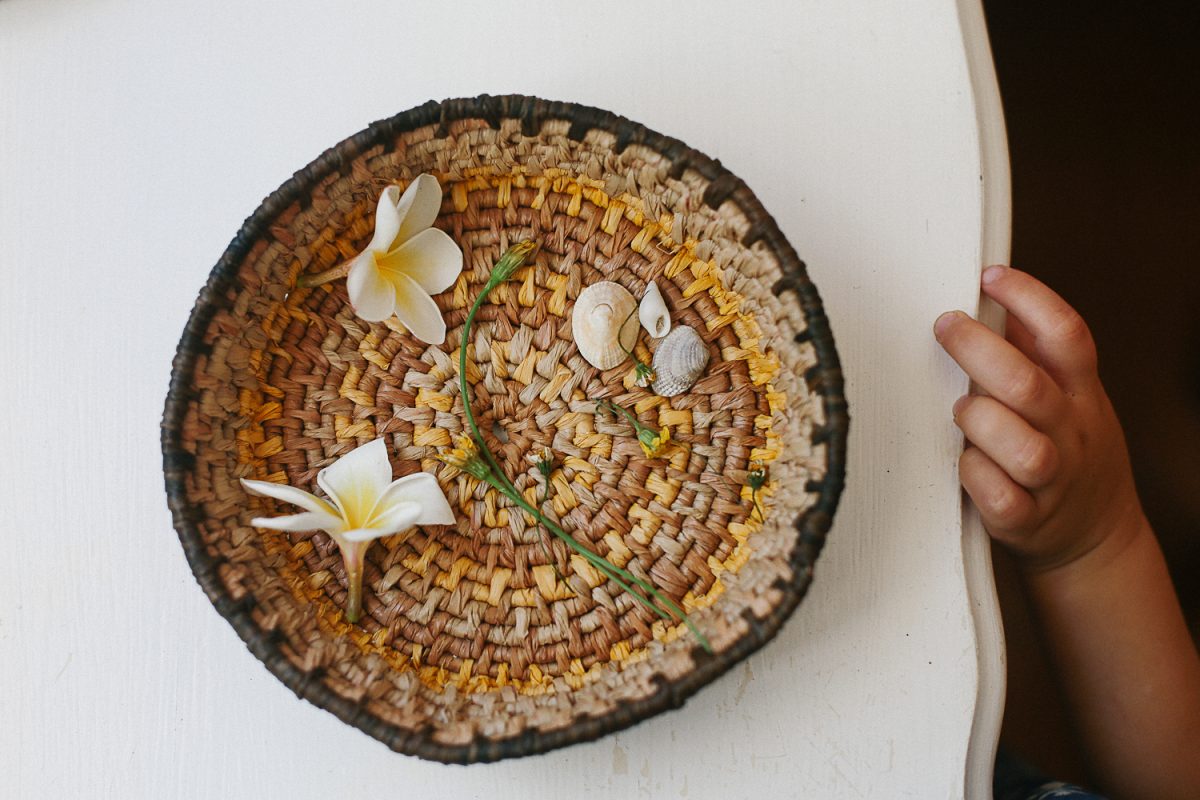toddler rhythm with whole family rhythms
As the dust settles on the start of the school year I’m turning my attention to my almost-two-year-old.
The night before Poet started school I had a sudden realisation that perhaps I wasn’t the one who would find the transition so challenging. Percy is her shadow and she is his little mother; their mutual adoration is palpable. And so it came as no surprise that I’ve had to use all manner of distraction techniques when the school bell rings every morning.
And for the first time it’s just the two of us – heading home wondering what the day will bring.
 Younger siblings often get the raw end of the school deal; their days at home are cut short and their settled afternoon naps are disrupted as they’re bundled into the car for school pick-up and afternoon activities. Subsequently, those at-home hours are precious pockets of time.
Younger siblings often get the raw end of the school deal; their days at home are cut short and their settled afternoon naps are disrupted as they’re bundled into the car for school pick-up and afternoon activities. Subsequently, those at-home hours are precious pockets of time.
But it’s challenging, isn’t it, to turn your attention away from the chores that are visible in every room of the house. And when emails are waiting and the washing has been sitting in the machine for hours and perhaps you just want a cup of tea and ten minutes on the couch, it’s all-too-easy (and perfectly ok!) to press play on Peppa Pig.
But here’s the thing; our kids have buckets and when they’re full with our love, attention and kind words, they often play independently – and happily. This in turn gives us time to catch-up and carry on. And in doing so we have the space and time to create a rhythm for ourselves…even if it’s one that takes days or weeks to establish.
Whenever I’m feeling a little lost on the parenting front and craving a bit of rhythm/routine, I return to my Whole Family Rhythms Guides, created by mum-of-four, Meagan Wilson. While I don’t follow them step-by-step I do seek guidance from Meagan’s words and ideas. They are full of gentle suggestions for establishing and maintaining a smooth home rhythm that benefits, nourishes and nurtures mother and child. Inspired by Steiner/Waldorf philosophy, there is a big emphasis on nature play and helping in the home (so yes, the chores will get done!).
 I reached out to Meagan last week and we chatted about creating peace and calm for our toddlers around the often hurried school clock. As always, she freely gave sound, practical advice for embracing rhythm regardless of how many hours you have at home. I hope you gain some insight from her words. And if you are interested in knowing more, you can find her guides (suitable for the Northern and Southern hemispheres) here and read a past interview with her here. She also regularly shares inspiring photos and comforting words on her instagram account – @wholefamilyrhythms.
I reached out to Meagan last week and we chatted about creating peace and calm for our toddlers around the often hurried school clock. As always, she freely gave sound, practical advice for embracing rhythm regardless of how many hours you have at home. I hope you gain some insight from her words. And if you are interested in knowing more, you can find her guides (suitable for the Northern and Southern hemispheres) here and read a past interview with her here. She also regularly shares inspiring photos and comforting words on her instagram account – @wholefamilyrhythms.
PS: How can you integrate an at-home rhythm with a strict 9-3 school routine?
Meagan: When you first set about planning your daily rhythm it is always important to focus on your family values. What is it you want to animate on a daily basis and why is this important to you? Next, you block out all the times you already know you have to commit to: school drop-offs, pick-ups, appointments, playdates, activities and finally, you look at the SPACE between all of these things. This is the space you can play with. Within this space you can create a daily rhythm that suits the age of your small child.
For children under the age of seven there are really only three facets of the daily rhythms that are absolutely required: consistent mealtime, sleeptime and playtime rituals. Other activities such as organised sport, artistic classes, even playdates do not need to prioritised and can be kept to a minimum. Our family loves going to a weekly playgroup mostly because it is so nourishing for me, the Mother. So this is the only out-of-home activity for the little ones on a weekly basis.
Get creative with the way you play with the school routine. Do you need to find some time outside with your younger children each day? Could you linger in the schoolyard or the park next door after drop-off or before pick-up each day? Are you packing daily lunches for your older children? If so, why not also pack a lunch or snack for you and your toddler each day to enjoy at a local park in the morning? Can you order groceries online or go to the shops on the weekends when someone else is home with the children? Can you assign one day a fortnight for appointments and stick to this day when booking in?
 PS: How can the busyness of the school week affect our little ones at home?
PS: How can the busyness of the school week affect our little ones at home?
Meagan: Structure is lovely for young children but feeling hurried or rushed is not. The difference is not so much in the actual events or deadlines but in the way you approach them. If you can implement habits and rhythms in your home that help you to stay on track at ‘rush hour’(often before school and dinner time) you can use the 9-3 structure to your advantage. It may feel almost impossible not to feel rushed in the mornings, but it is not impossible to keep this rushed feeling to yourself. Instead of developing habits of nagging and repetitively saying things like, “Hurry! We’re going to be late!”, try to prepare as much as you can in advance and create little habits that will help to support these peak times so that you can still remain balanced and calm. These habits will be different for everyone- it may be waking up and meditating before the kids wake up or doing a load of laundry in the evening so you feel you’re on top of the daily chores.
PS: What does your at-home rhythm look like?
Meagan: At the moment our own personal daily rhythm goes something like this:
In the mornings we have breakfast together, get dressed, brush hair and then the children have a ‘free play’ inside. By about 9:30 we head outside for some more free play as well as a few little outdoor chores. We head back in, have a snack and then the children continue playing indoors while I (or my husband) prepare lunch. We eat lunch together and the youngest then has a midday nap while the older children have a ‘quiet time’ which includes time alone, reading or a children’s meditation. When the baby wakes up we do a guided activity. Currently (and this changes with the children’s ages and the seasons) we Bake on Mondays, Paint on Tuesdays, Draw on Wednesdays, go to Playgroup on Thursdays and Model with Saltdough on Fridays. After this they play some more, sometimes we venture outside (if it’s not too cold and wet) and then get ready for dinner- the children setting the table and often helping with dinner prep. After dinner we head straight to the bath, get PJs on and brush teeth. Then the two smallest ones have 2 books in bed and have a ‘Healing Story’ told for them. Then our 6 year-old has a chapter book read to her and finally we head to our 8 year old’s room and read him a chapter from his chosen chapter book. Although he reads on his own, but we still feel it’s important to make time to read aloud for him too and to take this time to connect with him one-on-one.
PS: How do you fit household chores and dinner prep around these activities?
Meagan: I also have my own Daily Rhythm that is slightly different from the children’s. Because they spend so much of their day in ‘free play’ I spend the majority of that time doing household chores. In the mornings I generally put a load of laundry on, dry it by lunch and fold in the afternoons before pick-up time. I often focus on cleaning one room each day so that I have gotten through the entire house by the end of the week without having spent hours on one given day cleaning. I will also fully disclose that we have the privilege of having a cleaner come once a week. Even when our budget has been unbelievably tight, I have forgone many other luxuries to make sure this was a possibility. Being a neat-freak, this is something that really puts me at ease and enables me to ‘let go’ and focus on what’s most important to me. This is an example of being really clear about what your family values on and working with those to create a flow that works for you personally. I meal plan because so much of ‘making dinner’ is in the deciding what to have and getting the ingredients out. Some days I prep by cutting veggies early that can be thrown together at the last minute and other days I throw everything in a crockpot if I know we’re going to be extra busy that night.
PS: What are the benefits of a home rhythm for mums and their little ones?
Meagan: Daily, weekly and seasonal rhythms are the anchors that provide security and happiness to children. With a strong daily rhythm a child knows what to expect and what is expected. With rhythm, simple daily activities (chores, self-care, mealtimes) become habits instead of arguments. A strong daily rhythm is the backbone to creating strong boundaries and animating gentle discipline. When something (for example, bringing a lunchbox to the sink, putting the leftovers in the compost and putting the lunch-tins in the dishwasher) becomes habit there is no need for nagging and there is no push back. It is a non-negotiable. It is simply what we do in our family.
PS: Finally, what are your top five activities for toddlers and pre-schoolers?
Meagan:
- uninterrupted and free inside play – building with blocks, imaginary play like dressing up, playing Mama and Papas, playing with small animals or dolls
- uninterrupted and free outside play – scooping sand & mixing dirt (or snow), running, jumping, hopping, digging, watching or listening to birds or insects
- helping in the kitchen or home – pouring, scooping, cleaning dishes with a little apron on, scrubbing apples and peeling them, helping to cut soft fruit, stirring, folding napkins, shining shoes, polishing wooden toys with beeswax, setting the table
- an artistic activity – watercolour painting, drawing or modelling with saltdough
- helping in the garden – digging, planting, patting dirt, watering, weeding
This is a sponsored post. Thank you so much for supporting the brands who so generously support me.




Thank you for this fantastic post!!! I have been following Megans blog for years and it’s always so inspiring. I’m always so fascinated by other people’s rhythms and routines.
This is so helpful!
Such as informative post, it is so true we often forget about the impact on siblings when they are left at home. For us I would say the opposite is true: since relocating (Australia to NZ), my eldest son now resists kindy where previously he loved going. After worrying like crazy about him, it occurred to me that the issue wasn’t that he disliked kindy. Rather, he loves being at home with his little sister & Dad. They play and do fun stuff – of course he would rather stay at home!
A little self reflection goes a long way toward releasing mother guilt – thank goodness!
Thank you, I really needed to read this: I’ve lost my way and things were getting suffocating and painfully out of control. This blog post really gave me perspective and it will definitely help me find a new rhythm for our little family. Can’t wait to try a few of these tips. Thank you both.